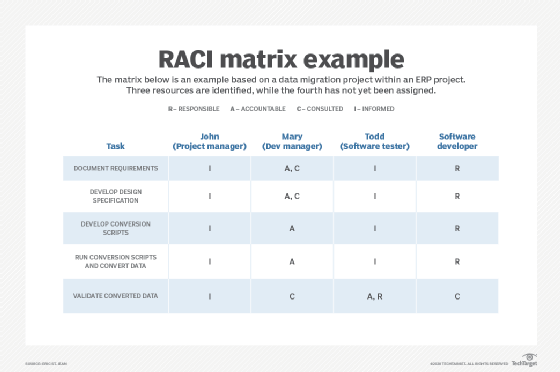
RACI matrix for project management success, with example
A lack of clarity around roles and responsibilities is a common cause of project failure. A RACI matrix can help project managers address this issue.
Projects are more likely to be successful if all the team members understand where their roles begin and end. A RACI matrix can help.
As a project manager or leader, you can use the model to create the right team, with optimal workload distribution.
What is a RACI matrix?
The RACI model holds that only one person should be explicitly accountable for project deliverables and that each person in a project should have a clear understanding of their role. A RACI matrix, based on a RACI model, is a responsibilities assignment chart that documents project roles and task boundaries so there's no confusion about who should do what. A RACI matrix, often referred to as a RACI chart, documents these in a clear visual so all team members can see their roles and responsibilities at a glance -- roles or people are listed across the top of the chart, tasks are listed on the left-hand side and a letter denotes the role a person serves for a given task.
A RACI matrix is a tool with wide applicability for any project. For example, project managers use a RACI matrix during an ERP implementation for a variety of projects, including data conversion and migration, developing training material, and requirements gathering -- either for an entire implementation project or a specific feature or module.
RACI is an acronym for critical project duties: responsible, accountable, consulted and informed. These are defined as follows:
Responsible. People assigned an "R" on a project must ensure they complete the task or get help completing it if they need it. Multiple people may be designated as "responsible" and be required to take on a task.
Accountable. This is the project team member who must ensure the tasks are completed. They assign and delegate tasks. Only one person can be designated as "accountable."
Consulted. These people may have specialized knowledge or a stake in the outcome of the task, so they provide subject-matter input. They do not work directly on completing the task.
Informed. People who are "informed" are affected by the project outcome, and other team members get them up to date on progress or decisions related to the project. Informed team members do not work directly on the task.
RACI matrix benefits
A RACI chart offers a number of benefits. Here's a look at five features it offers.
- Clear project overview. Sharing the RACI matrix is a great way to validate and educate team members about their roles and those of others on the team.
- Easy to create and use. Due to its simple, visual nature, you can easily share a RACI matrix with stakeholders. It also provides an at-a-glance snapshot of the project team size and each person's tasks and roles.
- Validation of responsibility and accountability for all tasks. Using a RACI matrix simplifies the process of ensuring that all tasks have someone responsible and accountable for them.
- Workload confirmation. By using some simple formulas and filtering, you can view the level of responsibility and number of tasks assigned to team members. If it becomes clear that someone has been assigned too many tasks, you can reassign the tasks early in the project.
- Task assignment verification. Sharing the RACI matrix facilitates discussion about the roles assigned to each team member and allows for new resources to be added. Sharing the matrix also makes it easy to move assignments from one employee to another.
Disadvantages of RACI matrix
A RACI chart can be very helpful for your project, but it also has some disadvantages. Here are a few of them.
- Time-consuming to create. The process of building your task list, adding people and assigning the RACI roles can take a long time, and it often requires multiple iterations as the project's planning phase progresses.
- Difficult to maintain. The RACI matrix can get out of date quickly once the project is underway.
- Potential duplicative effort. One disadvantage of a RACI matrix for project management is the potential overlap between the RACI matrix and other tools. If you're using a project management application, you may find that there's a lot of duplication between what's entered in that and your RACI matrix.
- Potentially too simplistic. If a project is larger in scope or the tasks are higher level, project managers may need to assign additional roles outside of those defined in RACI.
How to create a RACI matrix
The RACI matrix's biggest selling point is its simplicity. Here's how to create one.
- Determine the tasks. At the outset of a project, you may not be clear on the skill sets or people you'll need for the project, but you should know the tasks the team will need to complete. List those on the left-hand side of the matrix. Documenting project tasks helps you clarify the scope and ensure that you won't overlook key tasks. By doing this work upfront, you'll reduce the likelihood of identifying tasks late in your project.
- Determine required people or positions. Once you've identified the tasks, you can then start the process of determining who you'll need to ensure the tasks are completed successfully. List the roles or stakeholders at the top of the chart.
- Document the scope and roles required for the project. Each cell should identify the appropriate duty -- it can be spelled out or you can simply insert the first letter of the duty: R, A, C or I. The RACI matrix makes it easier for key stakeholders to visualize the scope of the project and identify the resources that the project will require, both in terms of project team members and those who will be consulted. Each task must have at least one "R" but can only have one "A."
- Get buy-in. Have all stakeholders agree on the distribution of responsibilities and understand what their roles are.









